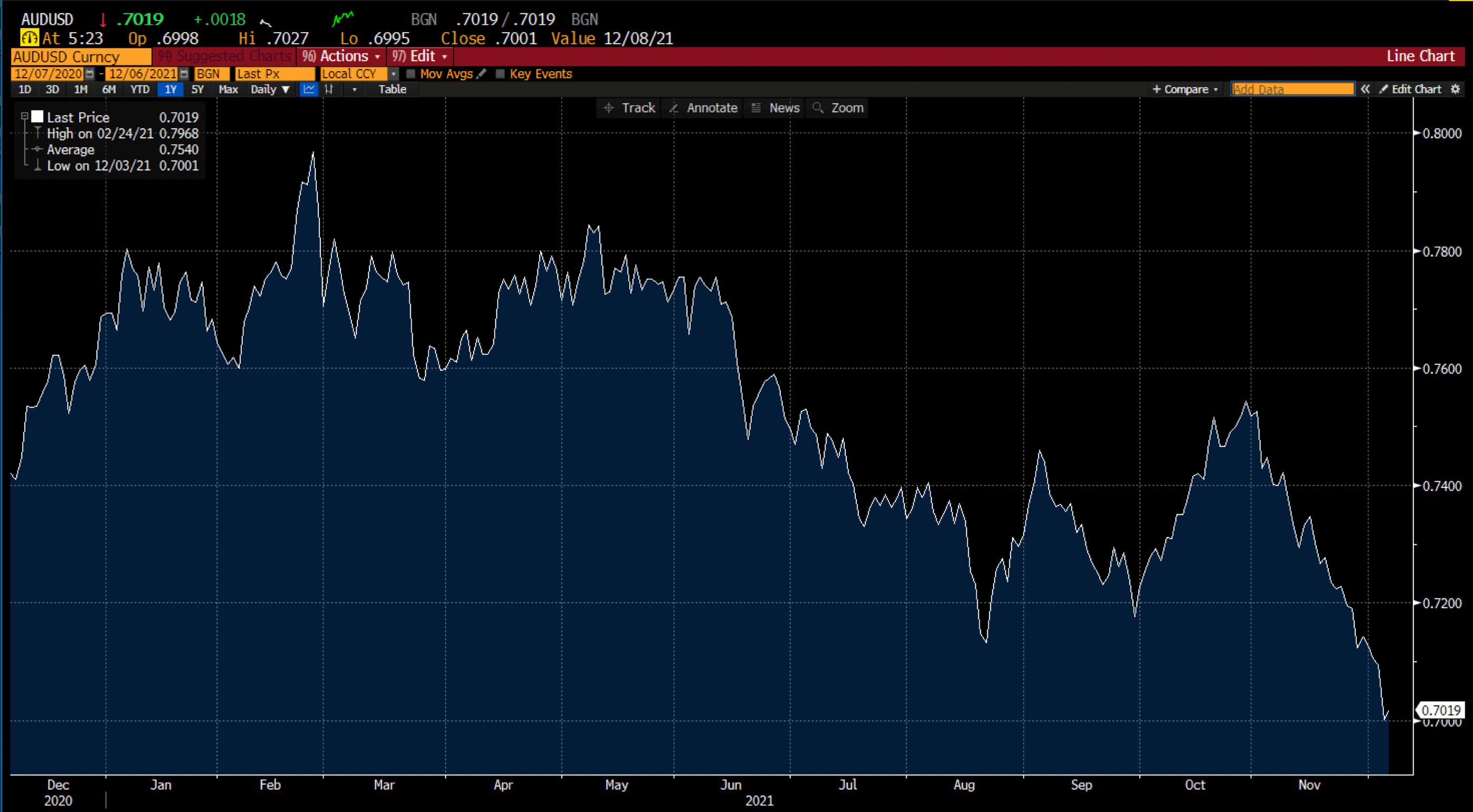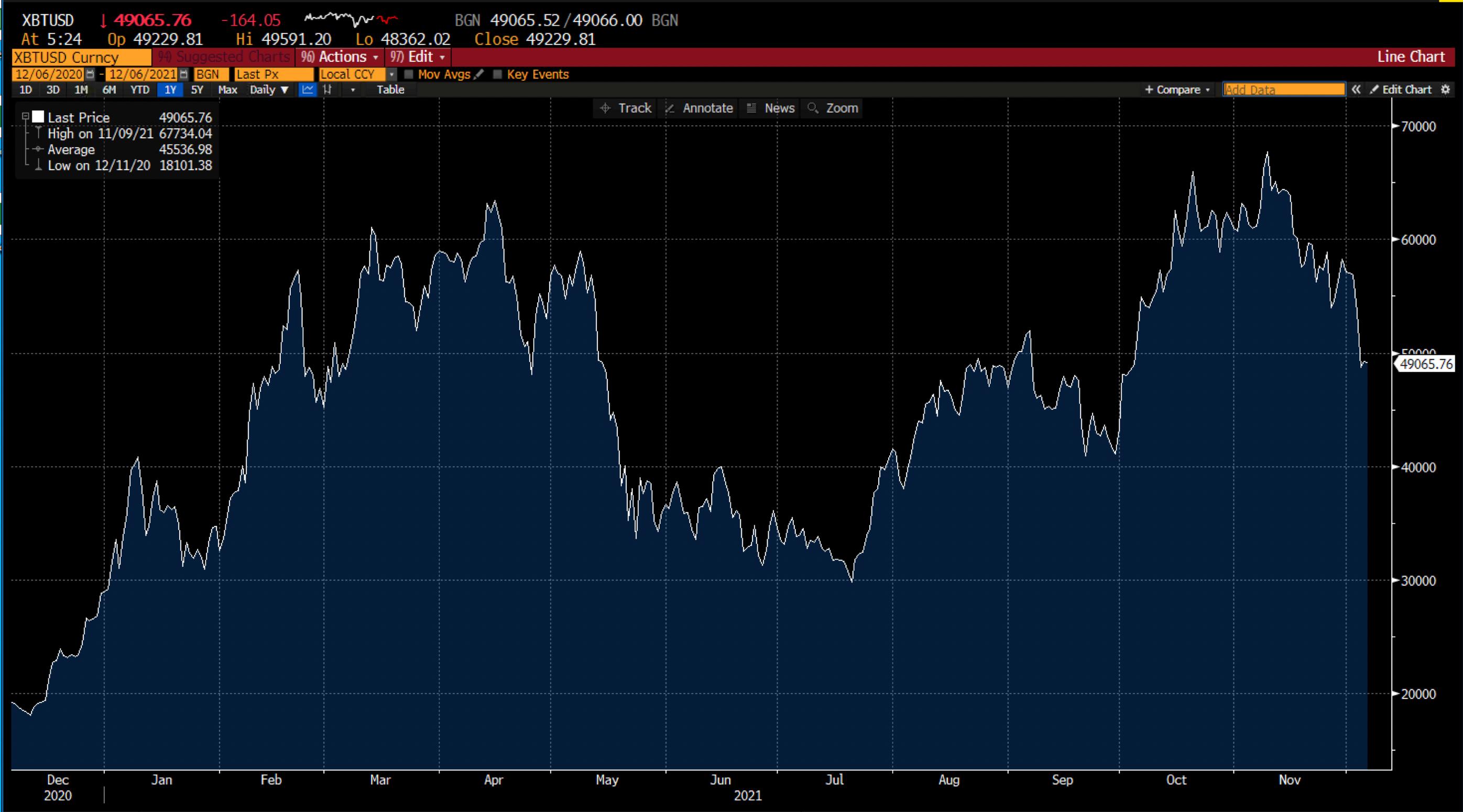US Indices
|
Name of the index |
Friday’s close |
Net Change |
Net Change (%) |
|
Dow Jones Industrial (US 30) |
34,580.08 |
-555.86 |
-1.58% |
|
Nasdaq (US Tech 100) |
15,712.04 |
-687.20 |
-4.19% |
|
S&P 500 (US 500) |
4,538.43 |
-116.84 |
-2.51% |
Source: Bloomberg
The US Indices experienced a volatile week. Fears over the Omicron variant and the Federal Reserve’s willingness to tighten monetary policy contributed to all 3 indices continuing their downward trend. This caused the CBOE volatility index to rise to a high of 35 intraday for the first time since January — readings above 30 indicate increased volatility and uncertainty.
Concerns about the COVID variant and Federal Reserve policy also affected the fixed income market. Last week, the 10-year US Treasury Yield fell to 1.36% on Friday, 3 Dec 2021, vs 1.52% on Monday. US Federal Reserve Chairman Jerome Powell expressed concern about inflation and suggested that the Fed might be able to curb inflation by accelerating the pace of the asset tapering program.
Known for its stability during an economic crisis, the utilities sector was the best-performing sector for the week. On the other hand, the Communication Sector has been the worst-performing sector for the week, mainly because of President Biden’s announcement to avoid a near-term lockdown.
This week, the focus will be on the Consumer Credit, the Core Consumer Price Index, and the Federal Budget.
Forex
Source: Bloomberg
The Swiss Franc and the Yen were the biggest winners in the currency markets, followed by the Dollar. Considered as safe-haven currencies, both the Swiss Franc and the Yen appreciated against global currencies and bond yields due to concerns about the spread of the Omicron variant which has led to restrictions around the world. Concerns about possible aggressive actions by the Federal Reserve to control inflation positively impacted the Dollar.
The Australian Dollar has continued to set new lows against the US Dollar, falling the most in 2 weeks since June 2021. Australia’s economy finds itself at the front-end of the global supply chain, making the following developments around Omicron significant. Since the last RBA meeting, the AUD/USD has fallen from 0.7532 to 0.7000. The RBA will meet this week to discuss monetary policy. Given the significant movements in AUD/USD since the last RBA meeting, it is important to watch the RBA’s interest rate decision on Tuesday, 7 Dec 2021, and commentary about the economic conditions driving their decision. AUD/USD broke its support at the 61.8% retracement level of $0.70500, making it the new resistance level — the new support level at 50% retracement is near $0.67500.
Following the release of a weaker-than-expected US jobs report, the dollar reversed gains to trade flat on the day. The report still contained positive revisions for previous months and solid details about the labour market. Despite the Omicron threat, markets quickly bounced back from disappointing jobs data after the Fed announced committing to its current level of tapering and asset purchases.
On the UK front, doubts have grown over the forecasted December interest rate set by the Bank of England after the rate setter noted that more information about Omicron might be beneficial before changing policy settings. If the Omicron strain threatens to slow consumption and production, policymakers do not want to risk hindering economic demand.
Commodities
Source: Bloomberg
As economic uncertainty increases, market watchers are turning to oil prices to gauge production and economic demand. This outlook shows weak economic prospects, with oil prices sliding for a sixth straight week- the longest stretch of weekly declines since 2018.
The price of WTI crude fell 0.63% to close at $66.26. The price of crude will first find support around $60.50 at the 61.8% retracement level, followed by the $55.50 range at the 50% retracement level. As of Friday’s close, WTI crude was trading near its 50-day moving average. Despite the threats posed by the Omicron strain, OPEC is committing to its plan of slowly increasing oil output by 400 barrels a day in January. This decision is significant amid heightened concerns in the global oil markets and was a leading factor in last week’s price declines.
In the metal markets, Gold ended the week flat at $1,783.18, a -0.03% change from last week’s initial opening price. Friday’s closing price positioned gold slightly above its first major support level of around $1,780 at the 38.2% retracement level. On the upside, resistance is found around the $1,800 mark at the 50% retracement level, followed by its second major support level of $1,820 at the 61.8% retracement level.
Despite ending flat on the week, Gold rose 1% against the dollar on Friday, 3 Dec 2021, benefiting from a flight to safety amidst Omicron uncertainty and a dip in US Treasury Yields.
Cryptocurrency
Source: Bloomberg
In a disastrous end to the week, Bitcoin prices fell sharply on Saturday, 4 Dec 2021, diving to a low near $43,000 before rebounding. In the 24 hours from Friday to Saturday, the world’s most prominent cryptocurrency lost around $10,000, equaling over 17% of its value being wiped out. The price of Ethereum, the second-largest cryptocurrency, also took a hit. Ethereum dived as low as $3,400 on Saturday, 4 Dec 2021, to shed 15% in 24 hours during the market sell-off.
Market losses accelerated early Saturday morning, with no apparent reason for the drop being evident. Cryptocurrencies started falling as stocks pulled back on Friday, 3 Dec 2021, leading investors to flock towards the safety of bonds. Mounting sentiment in tech stocks may also have translated over to the crypto space as investors started offloading. The sell-off also occurred amidst an unsettling sentiment around the chatter of impending crypto regulations from international governments.
Now trailing towards recovery, Bitcoin is settling slightly below its first major resistance levels near $54,400 at 50% retracement. In the event of additional market turmoil, Bitcoin should receive support at around $50,900 at 38.2% retracement. A breach of this key level would see Bitcoin’s next major support at the $46,600 mark at the 23.6% retracement level.
Trade US indices, forex, and commodities with options on DTrader and with CFDs on Deriv MT5 Financial and Financial STP accounts. Trade cryptocurrency with multipliers on DTrader and CFDs on Deriv MT5 Financial and Financial STP accounts.
Disclaimer:
Options trading is not available for clients residing within the European Union or the United Kingdom.
Cryptocurrency trading is not available for clients residing within the United Kingdom.



